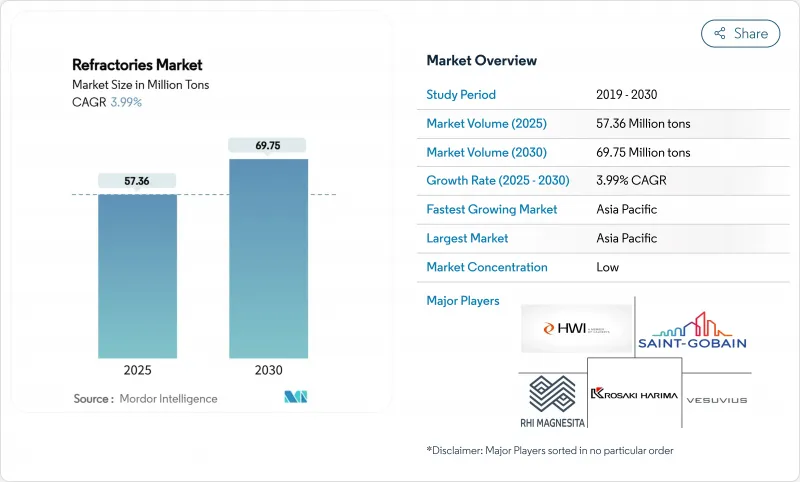
|
市場調査レポート
商品コード
1851403
耐火物:市場シェア分析、産業動向、統計、成長予測(2025年~2030年)Refractories - Market Share Analysis, Industry Trends & Statistics, Growth Forecasts (2025 - 2030) |
||||||
カスタマイズ可能
適宜更新あり
|
|||||||
| 耐火物:市場シェア分析、産業動向、統計、成長予測(2025年~2030年) |
|
出版日: 2025年07月22日
発行: Mordor Intelligence
ページ情報: 英文 120 Pages
納期: 2~3営業日
|
概要
耐火物市場規模は2025年に5,736万トンと推定され、予測期間(2025-2030年)のCAGRは3.99%で、2030年には6,975万トンに達すると予測されます。

この勢いは、耐火物市場が製鉄技術の転換、エネルギー集約型産業の拡大、規制当局の期待の高まりに適応できることを反映しています。アジアの製鉄所の生産能力拡大、水素ベースの直接還元鉄(DRI)炉への軸足移行、次世代バッテリー、セメント、廃棄物発電施設のスケールアップはすべて、当面の需要を補強するものです。同時に、シリカダストの規制強化や国境を越えた炭素関税は、材料の技術革新を加速させ、大手サプライヤー間の戦略的統合に拍車をかけています。例えば、RHIマグネシータは、販売量の減少にもかかわらず、2023年の調整後EBITAを7%増の4億900万ユーロに伸ばしました。
世界の耐火物市場動向と洞察
アジアの鉄鋼工場における急速な能力増強
アジア各地の鉄鋼生産能力増強がこれまでにない耐火物需要を牽引しており、中国では2024年上半期に12基、合計1,897万トンの高炉が新たに稼動します。老朽化したユニットを高効率炉に置き換えることで、キャンペーン寿命が延び、熱負荷が上昇するため、耐火物市場はより高品位のマグネシア・カーボンやモノリシック・ソリューションの技術革新を促しています。RHI Magnesita Indiaの2023-24年度の売上高は3,781カロールインドルピー(4億5,300万米ドル)で、9つの拠点で700社以上の顧客にサービスを提供しています。地域集中はリードタイムの短縮を通じて地元メーカーに利益をもたらすが、欧米のサプライヤーがシェアを維持するための課題でもあります。一方、韓国の生産台数は2024年に5.7%減少し、より広範な耐火物市場内での不均等な成長が浮き彫りになりました。
水素ベースの直接還元鉄炉へのシフト
水素ベースのDRIは温度プロファイルと雰囲気を変化させるため、優れた耐熱衝撃性と水素脆化耐性を持つ耐火物が要求されるMagnesita社の調査によると、「グリーンスチール」を目的とした電気溶解炉には、水素リッチガスに耐えることができる新しい耐火物化学物質が必要であることが確認されています。アルセロール・ミッタルが2025年にドイツのプロジェクトから撤退し、13億ユーロの補助金を返還したことは、経済的な不確実性を浮き彫りにしています。とはいえ、エネルギー経済研究所は、2050年までにDRグレードの鉄鉱石需要が10倍に増加すると予測しており、特殊DRIの長期的な可能性を示唆している、
マグカーボンレンガへの炭素排出ペナルティ
EUのカーボンボーダー関税と北米の脱炭素化政策が、従来のマグネシア・カーボンレンガの需要を抑制しています。ライフサイクルアセスメントによれば、カーボンレスマグネシア代替品はより低い環境影響をもたらすが、より広範な産業検証が必要です。米国が中国とメキシコのマグネシアカーボンレンガに課すアンチダンピング関税は、一部の生産者に対して236%に達しており、これがコスト圧力を高め、耐火物市場を低炭素ソリューションへと押しやっています。RHIマグネシタのハイリサイクルマグカーボンシリーズは暫定的な道筋を示すが、長期的にはカーボンフリーボンドやセラミックマトリックス複合材料が有利です。
セグメント分析
非粘土系耐火物はレビュー期間中CAGR 4.76%で成長し、2030年まで粘土系グレードを上回り続ける。非粘土質レンガは、水素ベースの製鉄、先端電池、廃棄物焼却炉に不可欠な優れた耐食性と耐熱衝撃性で繁栄しています。マグネサイトれんがは、スラグ化学に対する耐性で基礎製鉄の主流を占め、ジルコニアれんがは過酷なサイクルや超高温地帯で優れています。シリカれんがは依然としてコークス炉のチェッカーウォールに欠かせないが、粉塵の上限を50µg/m3とする結晶シリカ暴露規制の上昇により、使用量は抑えられています。クロマイトれんがは、強力な金属浸透抵抗性のおかげで、非鉄製錬の足場を維持しています。粘土の耐火物が数量のリーダーを維持する中で、これらの非粘土のカテゴリーが価値の成長を支えています。
粘土の耐火物は、高アルミナ質れんががトップで、2024年の耐火物市場シェアの55.43%を占めました。耐火粘土レンガは、中温の取鍋やボイラーに使用され、断熱性耐火物は、産業全体のエネルギー節約を解き放ちます。調査チームは、フライアッシュのジオポリマーレンガにおいて、1,100℃の曝露後に84 MPaの圧縮強度を達成し、粘土耐火物の循環型経済への道筋を示唆しました。サンゴバンの超高温セラミック、特にSiCとジルコニアは、1,400 °Cを超える性能の天井を伸ばし、ハイブリッド配合が従来の粘土/非粘土の隔たりを曖昧にすることを示しています。
耐火物市場レポートは、製品タイプ(非粘土耐火物と粘土耐火物)、エンドユーザー産業(鉄鋼、セメント、エネルギー・化学、非鉄金属、ガラス、セラミック、その他のエンドユーザー産業)、地域(アジア太平洋、北米、欧州、南米、中東・アフリカ)で区分されています。市場予測は数量(トン)で提供されます。
地域別分析
アジア太平洋地域は2024年に耐火物市場の73.81%を占め、2030年までCAGR 4.22%で成長すると予測されます。中国は高炉の近代化を続ける一方、老朽化した生産能力を閉鎖し、より高品位のレンガとキャスタブルの持続的な普及を推進しています。RHIマグネシタのCEOは、大規模な鉄鋼とセメントの拡張を反映して、国内の耐火物の年間成長率が6~13%になると予測しています。JFEホールディングスの22億6,000万米ドルの投資に支えられた日本のEAF技術へのシフトは、ライニング仕様をEAFに最適化されたベーシックミックスに方向転換させる。韓国は2024年に生産量が5.7%減少するが、プレミアムを必要とする高価値の鉄鋼製品に軸足を移すことを目指す耐火物中国と東南アジアでは、リチウムイオン電池のギガファクトリー建設が加速しており、この地域が耐火物市場の成長の核としての役割を担っています。
北米は成熟しつつも戦略的に重要な地域です。ミズーリ州フルトンにおけるHarbisonWalker International社の1,390万米ドルの拡張は、軽量モノリシック生産量を60%引き上げるもので、この地域の高価値用途へのコミットメントを体現するものです。OSHAによるシリカ粉塵規制の強化により、密閉型マテリアルハンドリングと低粉塵マテリアルへの投資が促進され、製品ポートフォリオが再構築されます。カナダは、特殊なDRI耐火物需要を刺激する可能性のあるグリーンアイアンの輸出で主導権を握ろうとしています。しかし、メキシコの競争力は、マグカーボンレンガのコストを高騰させる米国の反ダンピング関税によって弱められています。
環境政策では欧州がペースを握る。EUの炭素国境調整メカニズムは、高炭素のコストを引き上げ、カーボンフリーボンドやリサイクルソリューションの採用を促進します。アルセロール・ミッタルがドイツの水素鉄鋼プロジェクトに対する13億ユーロの補助金返還を決定したことは、グリーン転換における経済的負担を物語っています。サンゴバンがニューヨーク州ウィートフィールドに計画している4,000万米ドルのNorPro工場は、米国を拠点としながらも、欧州の触媒に対応するもので、大西洋を越えたサプライチェーンの統合を強調しています。中東とアフリカでは、サウジアラビアの産業多角化と南アフリカの鉱業ベンチャーが有望であるが、政治的な確実性とインフラ格差がプロジェクトのペースに影響します。
その他の特典:
- エクセル形式の市場予測(ME)シート
- 3ヶ月間のアナリストサポート
よくあるご質問
目次
第1章 イントロダクション
- 調査の前提条件と市場の定義
- 調査範囲
第2章 調査手法
第3章 エグゼクティブサマリー
第4章 市場情勢
- 市場概要
- 市場促進要因
- アジア鉄鋼工場の急速な能力増強
- 水素直接還元炉へのシフト
- セメント窯の代替燃料への転換
- 高温セラミックスを用いた大型実用蓄電池の成長
- 廃棄物焼却炉用の新しい超低孔質レンガ
- 市場抑制要因
- マグカーボンレンガに対する炭素排出罰則
- 冶金グレードボーキサイトとマグネサイトの供給変動性
- OECD諸国における職業性シリカ粉塵規制の強化
- バリューチェーン分析
- ポーターのファイブフォース
- 供給企業の交渉力
- 買い手の交渉力
- 新規参入業者の脅威
- 代替品の脅威
- 競合の程度
第5章 市場規模と成長予測
- 製品タイプ別
- 非クレイ耐火物
- マグネサイトレンガ
- ジルコニア・ブリック
- シリカレンガ
- クロマイトれんが
- その他(炭化物、ケイ酸塩)
- クレイ耐火物
- ハイアルミナ
- ファイヤークレイ
- 絶縁
- 非クレイ耐火物
- エンドユーザー業界別
- 鉄鋼
- セメント
- エネルギーと化学
- 非鉄金属
- ガラス
- セラミック
- その他のエンドユーザー産業(紙パルプ,廃棄物発電)
- 地域別
- アジア太平洋地域
- 中国
- インド
- 日本
- 韓国
- その他アジア太平洋地域
- 北米
- 米国
- カナダ
- メキシコ
- 欧州
- ドイツ
- 英国
- フランス
- イタリア
- ロシア
- その他欧州地域
- 南米
- ブラジル
- アルゼンチン
- その他南米
- 中東・アフリカ
- サウジアラビア
- 南アフリカ
- その他中東・アフリカ地域
- アジア太平洋地域
第6章 競合情勢
- 市場集中度
- 戦略的動向
- 市場シェア分析
- 企業プロファイル
- Chosun Refractories
- Gouda Refractories Group
- HarbisonWalker International
- IFGL
- Imerys
- Krosaki Harima Corporation
- Liaoning Qinghua Refractory Material Co., Ltd.
- Monolithisch India Limited
- Morgan Advanced Materials
- Puyang Refractories Group Co.,Ltd.
- Rath-Group
- Refratechnik
- RHI Magnesita
- Saint-Gobain
- SHINAGAWA REFRACTORIES CO., LTD.
- Vesuvius

